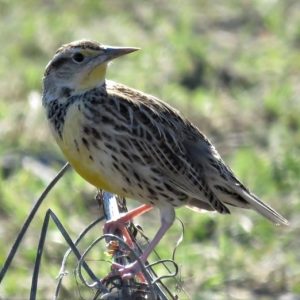Whether they are calling, fussing, humming, begging for food, or singing to find a mate, birds can make an amazing variety of sounds.

Some bird song is considered to be a beautiful sound that can be compared to music, while other birds produce what can only described as “noise”.
Other birds are masters of impersonation. I have been duped on more than one occasion into thinking that a Cooper’s Hawk was hunting in the back yard. A Blue Jay had impersonated the Hawk’s call to scare other birds away from the feeder so it didn’t have to wait its turn. As I write I can hear a Mockingbird outside and there are impressions of other birds in its call – Robins, Cardinals, Wrens, and more.
When I moved here a few years ago from far and distant shores the only birds I could identify from their calls were European Starlings and House Sparrows. Learning how to recognize other common back yard birds took a while. The use of mnemonics helped, from the “cheer-cheer-cheer-purty-purty-purty” of the Northern Cardinal to the “tea-kettle, tea-kettle, tea-kettle” of the Carolina Wren.
In May last year my wife and I visited LLELA hoping to see Indigo and Painted Buntings for the first time, but we were unable to spot them. We were advised to learn their calls so we could stop and look out for the birds when we heard they were close. We listened to some sound recordings and set off the following week to track them down – we were able to put observations of both species on iNaturalist when we returned home. Both Buntings make an appearance in the video – the clips were recorded that day.
Learning bird songs can also help to distinguish between similar looking species. I recently photographed a bird but was unable to tell whether it was an Eastern or Western Meadowlark. Their ranges overlap in this area and they look almost identical. Their vocalizations are different so I was advised to record some audio if I see one again.


I have put some links below the video – websites with that include sound files on the identification page of each bird species, and mobile phone apps with sound samples that can be used to help with identification in the field.
All of the birds in the video are labeled, but how many do you think you could identify from the sounds alone ?
Links
Cornell Lab of Ornithology’s All About Birds guide. https://www.allaboutbirds.org/guide/search/
Audubon’s guide to American Birds. http://www.audubon.org/bird-guide
Bird audio samples on eNature.com http://www.enature.com/birding/audio.asp
xeno-canto is a website dedicated to sharing bird sounds from all over the world. http://www.xeno-canto.org/
Audubon Bird Guide mobile app. http://www.audubon.org/apps
Cornell Lab’s Merlin bird ID mobile app. http://merlin.allaboutbirds.org/
iBird Guide to Birds mobile app. http://ibird.com/







Great video, thanks for posting.
For the last week there have been birds in the trees here in Mansfield that are croaking incessantly. There’s no break in between notes, it’s just a loud, repetitive croaking, quaking sound . I can’t get a look at the little guys and the inability to recognize who they are is driving me crazy. Any ideas?